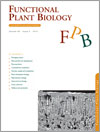
Functional Plant Biology
Volume 39 Number 2 2012
FP11172 Differential shrinkage of mesophyll cells in transpiring cotton leaves: implications for static and dynamic pools of water, and for water transport pathways
All leaves lose water on hot dry days and thin ones often wilt (e.g. pumpkin) because their cells shrink. This study of cell shrinkage in cotton leaves after considerable water loss has shown that they have a mass of cells that do not shrink, thus helping the leaf resist wilting. It is likely that many similar leaves may resist wilting by this mechanism.
FP11185 Hydraulic connectivity from roots to branches depicted through sap flow: analysis on a Quercus suber tree
Knowledge on the hydraulic architecture of trees is important to understand their survival and growth. The study of xylem connections in a cork oak tree showed that above ground xylem was sectorially connected to crown parts on the same orientation, whereas roots were connected to the whole crown. The sectoriality of aboveground xylem limits the spread of embolisms, but the integration in roots favours resource acquisition though allowing the spread of root diseases.
FP11244 Water use, water use efficiency and drought resistance among warm-season turfgrasses in shallow soil profiles
Maintaining functional turfgrass under limited water resources can be achieved by using species with drought resistance. Under shallow soil profiles typical of urban environments, water use characteristics of four commercial turfgrass species were evaluated and the bermudagrasses were found to have the best drought resistance. This research suggests that bermudagrasses may be preferable where water resources are limiting in urban environments.
FP11229 Ecotypic responses of switchgrass to altered precipitation
Climate change is projected to alter precipitation patterns, creating new environments for plants. This research sought to determine the responses of different ecotypes of switchgrass to changes in precipitation, with results showing differences in physiological responses between ecotypes and biomass responses to precipitation changes. The interactions between ecotype and precipitation suggest it may not always be necessary to consider localised adaptation when predicting species responses across a large geographic gradient.
FP11184 Internode elongation pattern and differential response of rice genotypes to varying levels of flood water
Rising sea level, erratic heavy rainfall and impeded drainage leads to inundation of low-lying paddy fields. This study showed the response of rice cultivars from different ecosystems varied predominantly in internodal length, blade and sheath length under varying levels of floodwater. Therefore, breeding rice varieties with specific adaptation mechanisms to their relevant flood-prone environment is necessary to improve grain yield.
FP11150 Production of small starch granules by expression of a tandem-repeat of a family 20 starch-binding domain (SBD3-SBD5) in an amylose-free potato genetic background
Starch granule size is a very important parameter in food and non-food applications. In this study, transgenic potato plants capable of producing small starch granules were generated, using genetic engineering approaches. Due to intrinsic purity of potato starch, small starch granules produced in this study may make them particularly suitable for making starch noodles and films in industry.
FP11158 Metabolite profiling of wheat flag leaf and grains during grain filling phase as affected by sulfur fertilisation
Increasing prices for wheat products and the decrease of atmospheric sulphur emissions by industry call for an adjusted agricultural management to maintain yield and product quality. We evaluated the effects of sulphur fertilisation including apparent sulphur deficiency and a novel late application on the composition of metabolites in flag leaves and grain. A considerable influence of sulphur fertilisation not only on sulphur rich amino acids but also on the sugar metabolism was detected and late sulphur fertilisation can help to prevent sulphur deficiency.
FP11193 Multivariate associations of flavonoid and biomass accumulation in white clover (Trifolium repens) under drought
Drought impairs biomass production of white clover and increases the levels of flavonols. The responses of a white clover population to drought reveal that quercetin glycoside accumulation is associated with the retention of biomass production. The underlying potential genetic variation for quercetin glycoside accumulation, linked to herbage yield, will enhance selection in breeding programs for improving white clover drought performance.




